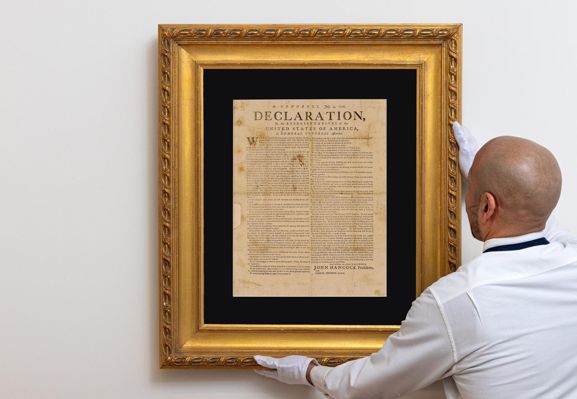소더비 미 독립선언서(1776) 경매...예상가 2-4백만불
Sotheby’s To Offer Rare Printing of the Declaration of Independence: The July 1776 Essex Broadside
One of the Earliest Printings of America’s Founding Text Estimate $2-4 million

NEW YORK, 13 JANUARY 2025 - Sotheby’s will offer an exceedingly rare July 1776 printing of the Declaration of Independence: The Essex Broadside, in a standalone live auction on 24 January, estimated to achieve $2-4 million. Attributed to Robert Luist Fowle of Exeter, this Goodspeed’s-Sang-Streeter copy is one of thirteen contemporary broadsides of the Declaration of Independence issued in 1776. Of these, only 10 examples of the Essex broadside are known to exist, with the majority today being held by prestigious institutional collections.
This Declaration appears at a time of growing appreciation for founding documents among collectors, fueled by their extraordinary rarity and profound historical importance. This Essex Broadside is poised to join the ranks of the most valuable founding documents ever offered at auction.
The document will be sold alongside Sotheby’s Visions of America presented in partnership with Cadillac, a week-long series of auctions, exhibitions, and immersive experiences which celebrates American artistry and craftsmanship. Comprising over 500 exceptional examples of American art and objects spanning from the 17th century to the present day, the auction series offers both new and established collectors an opportunity to experience a diverse range of outstanding American works. This year, renowned designer and creative director Ken Fulk joins as guest curator, bringing his signature "magic-making" to the week with a carefully selected collection of 18 exceptional works that highlight America's rich cultural legacy.
The Declaration of Independence: The July 1776 Essex Broadside:
The Declaration of Independence, finalized on the evening of 4 July 1776 after three days of intense deliberation by the Continental Congress, stands as a defining moment in American history. That night, a manuscript was delivered to John Dunlap, the Congress's official printer, who swiftly prepared it for printing, ensuring its immediate dissemination to the public and the colonies.
Dunlap’s broadside was distributed throughout the thirteen colonies, and these were used as copy texts for other local printers, who produced their own editions, which were themselves often reprinted in to meet the widespread demand for tangible proof of independence.
Of the thirteen known broadside editions printed in 1776, it is believed that only around one hundred copies have survived. Today, the Dunlap first printing constitutes more than a quarter of these existing copies, and most of the 1776 broadside declarations—at least seventy-nine—are housed in public institutions.
Among the thirteen broadsides printed during this period is the Essex printing attributed to Robert Luist Fowle of New Hampshire. Fowle’s printing stands out from other editions for its distinctive two-column format, reminiscent of biblical texts; it retains the opening headline format of Dunlap's broadside but incorporates italic type. Fowle’s hurry to publish the news of independence is shown by his initial misspelling of the names of the president and secretary of Congress. He did quickly correct the spelling of John Hancock’s name, as shown on this copy, but Charles Thomson continued to carry extraneous 'p' in his last name.
This printing was previously held in two legendary Americana collections—The Streeter Collection, assembled by Thomas W. Streeter, considered one of the greatest private collections of Americana ever created, with a focus on early American history, exploration, and settlement, including unique editions that chronicle the expansion and development of the United States (sold at Sotheby’s in 1967), and the Sang Collection, built by Philip and Elsie Sang, prominent Chicago collectors known for their deep interest in American history, particularly the Revolutionary War and Declaration of Independence and its Signers (sold at Sotheby’s in 1978).




 실비아월드앤포김 갤러리 AI 시대의 미술 그룹전 'SYMBIOSIS: Art...
실비아월드앤포김 갤러리 AI 시대의 미술 그룹전 'SYMBIOSIS: Art...

